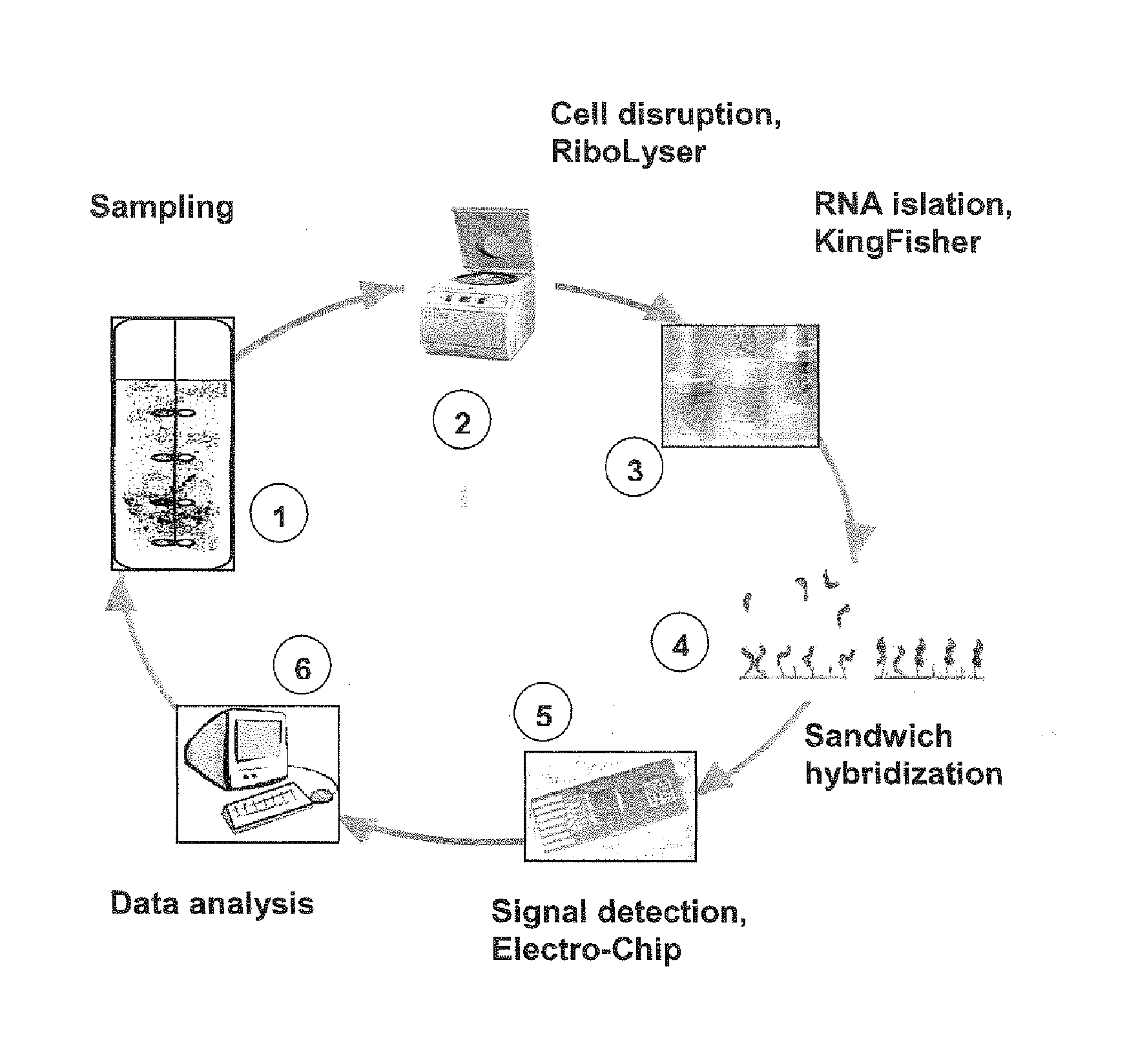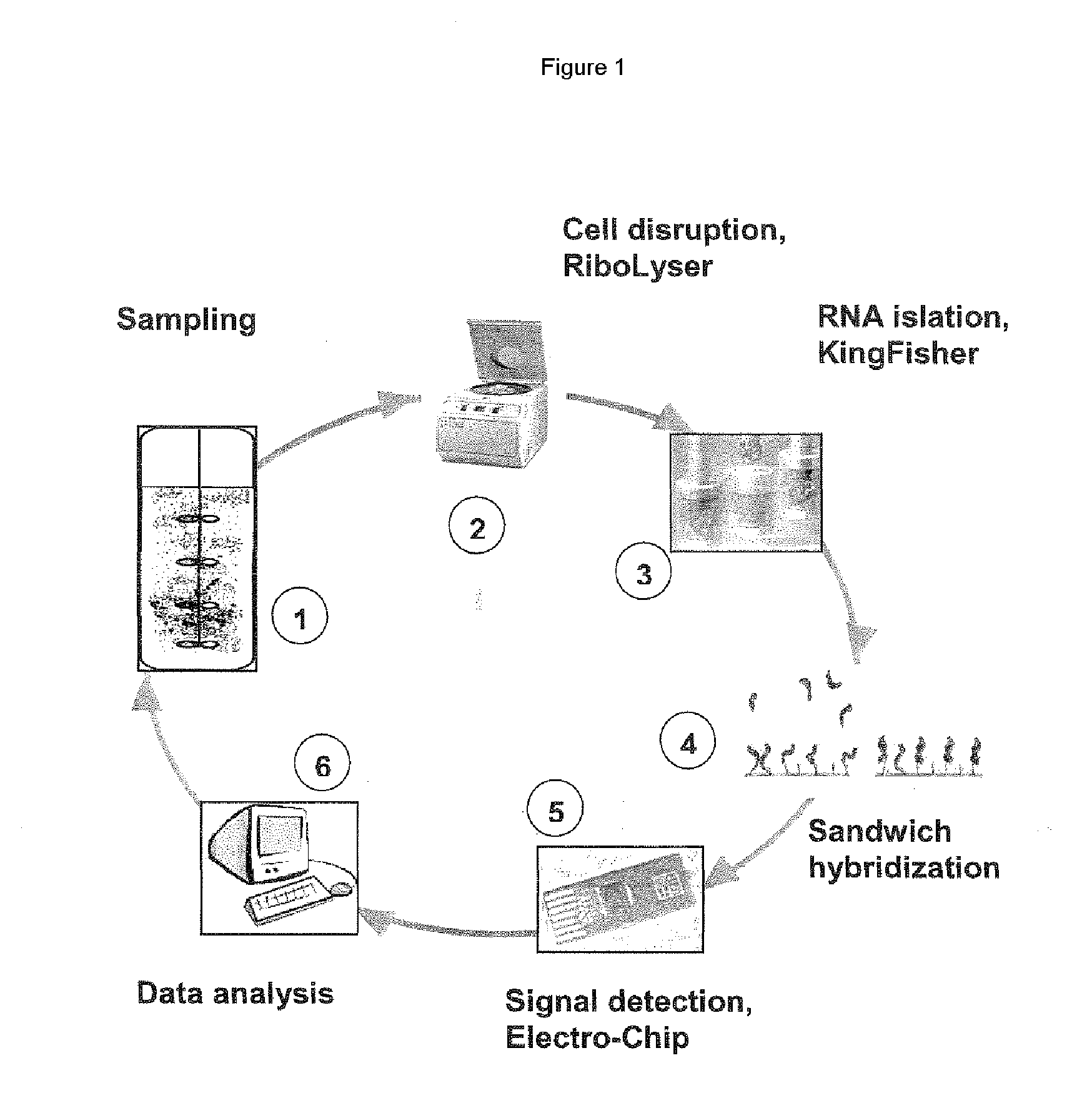Nucleic acid-binding chips for the detection of phosphate deficiency conditions in the framework of bioprocess monitoring
a technology of phosphate deficiency and nucleic acid binding chips, applied in biochemical apparatus and processes, specific use bioreactors/fermenters, after-treatment of biomass, etc., can solve the problem of special metabolic situations, inability to simply apply additional gene probes for recording additional, and biological problems, etc. problem, to achieve the effect of rapid readability and number of occupiable places
- Summary
- Abstract
- Description
- Claims
- Application Information
AI Technical Summary
Benefits of technology
Problems solved by technology
Method used
Image
Examples
example 1
Identification of the Gene Probes by Chip Analyses
Culturing of Bacteria and Isolation of Samples
[0236] Cells of the Bacillus licheniformis DSM13 strain (obtainable from Deutsche Sammlung von Mikroorganismen und Zellkulturen GmbH, Mascheroder Weg 1b, 38124 Braunschweig, Germany; http: / / www.dsmz.de) were cultured in phosphate-limited, synthetic Belitsky minimal medium (0.28 mM final concentration) with constant shaking at 270 rpm and 37° C. Said medium has the following composition: (1.) basic medium (pH 7.5): 0.015 M (NH4)2SO4, 0.008 M MgSO4×7H2O, 0.027 M KCl, 0.007 M sodium citrate×2H2O, 0.050 M Tris-HCl and 0.009 M glutamic acid; (2.) supplements: 0.2 M KH2PO4, 0.039 M L-tryptophan-HCl, 1 M CaCl2×2H2O, 0.0005 M FeSO4×7H2O, 0.025 M MnSO4×4H2O and 20% (w / v) glucose; and as (3.) medium supplementing plan: 0.14 ml of KH2PO4, 0.2 ml of CaCl2, 0.2 ml of FeSO4, 0.04 ml of MnSO4, 1 ml of glucose. All values refer to 100 ml of basic medium.
[0237] In the course of establishing the growt...
example 2
Genes Induced Under Phosphate Deficiency
[0247] Table 1 below lists all 235 Bacillus licheniformis DSM13 genes determined in Example 1 whose induction (of at least a factor of 3) was observed under the conditions of phosphate deficiency described in Example 1. The first two columns indicate the particular name of the derived protein and, respectively, its abbreviation (if available); the “Bli number” corresponds to the “locus_tag” of the B. licheniformis complete genome accessible under the entry AE017333 (bases 1 to 4 222 645) in the GenBank database (National Center for Biotechnology Information NCBI, National Institutes of Health, Bethesda, Md., USA; http: / / www.ncbi.nlm.nih.gov; as of 12.2.2004); this is followed by the factors of increasing the concentration of the in each case corresponding mRNAs, observed at the times indicated at the top.
TABLE 1The 235 Bacillus licheniformis DSM13 genes determined inExample 1, whose induction (of at least a factor of 3) underphosphate defi...
example 3
Genes which are Markedly Induced Especially Under Phosphate Deficiency
[0248] Table 2 below lists all the Bacillus licheniformis DSM13 genes determined in Example 1, whose induction under the conditions of phosphate deficiency described in Example 1 has been at least a factor of 10 at any of the times of measurement and which may be classified as comparatively specific for phosphate deficiency on the basis of comparative experiments (data not shown). These are 47 genes in total.
[0249] The column headers are the same as in the preceding example. In addition, the first column indicates the sequence numbers of the particular DNA and amino acid sequences in the sequence listing of the present application. Specific features of the particular sequences, which appear as free text in the sequence listing have been added under the heading Gene name / gene function.
TABLE 2The 47 Bacillus licheniformis DSM13 genes determined inExample 1, whose induction caused especially by phosphatedeficien...
PUM
| Property | Measurement | Unit |
|---|---|---|
| nucleic acid- | aaaaa | aaaaa |
| molecular-weight | aaaaa | aaaaa |
| molecular weight | aaaaa | aaaaa |
Abstract
Description
Claims
Application Information
 Login to View More
Login to View More - R&D
- Intellectual Property
- Life Sciences
- Materials
- Tech Scout
- Unparalleled Data Quality
- Higher Quality Content
- 60% Fewer Hallucinations
Browse by: Latest US Patents, China's latest patents, Technical Efficacy Thesaurus, Application Domain, Technology Topic, Popular Technical Reports.
© 2025 PatSnap. All rights reserved.Legal|Privacy policy|Modern Slavery Act Transparency Statement|Sitemap|About US| Contact US: help@patsnap.com


